Advantages and Disadvantages of Social Networks in Business Research
VerifiedAdded on 2020/04/01
|10
|2194
|42
Report
AI Summary
This report presents a comprehensive business research proposal focusing on the advantages and disadvantages of social networks in business. The study begins with an introduction, outlining the significance of social networks in today's business environment. It defines the project's objectives, scope, and includes a detailed literature review exploring existing research on the topic. The proposal formulates specific research questions and hypotheses, followed by a description of the research design and methodology, which combines both qualitative and quantitative research approaches. The methodology section explains data collection methods, including interviews and surveys, and addresses data reliability and validity. The report also acknowledges research limitations and provides a time schedule for the research plan. The conclusion summarizes the key findings and implications of the study. The research aims to identify the positive and negative impacts of social networks on businesses, providing insights for businesses utilizing social media platforms. A research onion diagram is included in the appendix.
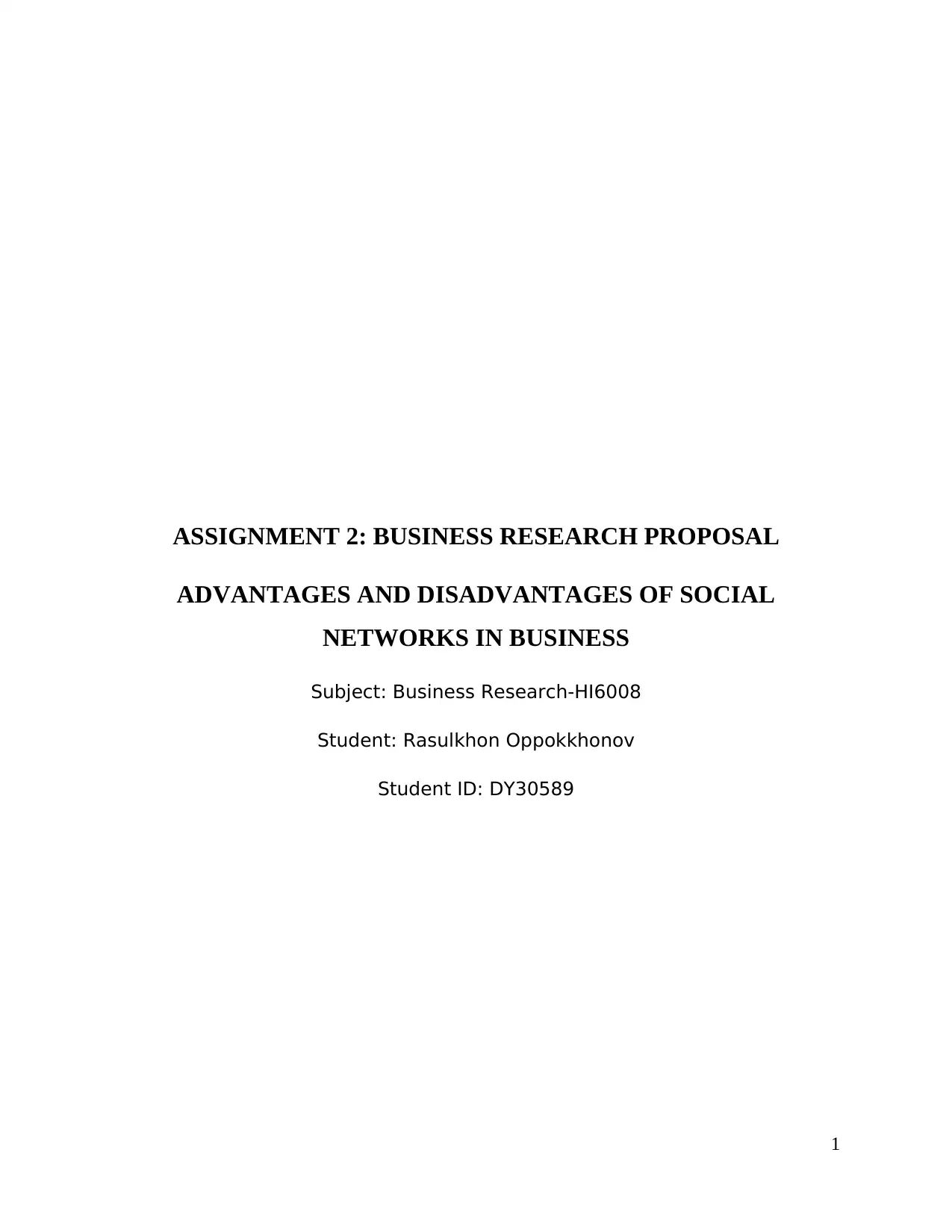
ASSIGNMENT 2: BUSINESS RESEARCH PROPOSAL
ADVANTAGES AND DISADVANTAGES OF SOCIAL
NETWORKS IN BUSINESS
Subject: Business Research-HI6008
Student: Rasulkhon Oppokkhonov
Student ID: DY30589
1
ADVANTAGES AND DISADVANTAGES OF SOCIAL
NETWORKS IN BUSINESS
Subject: Business Research-HI6008
Student: Rasulkhon Oppokkhonov
Student ID: DY30589
1
Paraphrase This Document
Need a fresh take? Get an instant paraphrase of this document with our AI Paraphraser

Table of Contents
Assignment 2: Business research proposal......................................................................................3
1. Introduction..................................................................................................................................3
2. Project Objective.........................................................................................................................3
3. Project Scope...............................................................................................................................3
4. Literature Review........................................................................................................................3
5. Research Questions/Hypothesis...................................................................................................4
6. Research Design and Methodology.............................................................................................4
7. Research Limitations...................................................................................................................7
8. Time Schedule (Research plan)...................................................................................................7
9. Conclusion...................................................................................................................................8
10.Works Cited................................................................................................................................8
11. Appendix..................................................................................................................................10
2
Assignment 2: Business research proposal......................................................................................3
1. Introduction..................................................................................................................................3
2. Project Objective.........................................................................................................................3
3. Project Scope...............................................................................................................................3
4. Literature Review........................................................................................................................3
5. Research Questions/Hypothesis...................................................................................................4
6. Research Design and Methodology.............................................................................................4
7. Research Limitations...................................................................................................................7
8. Time Schedule (Research plan)...................................................................................................7
9. Conclusion...................................................................................................................................8
10.Works Cited................................................................................................................................8
11. Appendix..................................................................................................................................10
2

1. Introduction
At present day, the social network has become an indivisible part of peoples’ lives, which
provides significant advantages to the marketers to understand their customers and stay
connected with them. Although, social networks offer immense opportunities to business;
however, it has some drawbacks too that may harm the business of a company, if not handled
properly (Ku, D. 2016). The study involves identifying the research methods and techniques that
will be used to conduct and complete the research successfully.
2. Project Objective
To identify the positive impacts of social networks on business
To identify the negative impacts of social networks on business
3. Project Scope
As social networks are considered as one of the most effective modes of marketing and way of
attracting customers; hence, the present study has huge scope to analyse the strengths and
weaknesses of social networks in business. The findings of the present research will be useful for
present day business organisations those use social networks.
4. Literature Review
Among different advantages, one of the most important advantages of social networks is it
provides a company the opportunity of promoting its products and services to not only the
regional or national customers but also to the global customers. Thus, it helps to grow the
customer base of a company by developing an effective communication with them. It also
provides information about the competitors that is important for developing future business
strategies (Emily Copp 2016). The social network is the easiest way of identifying the
preference, demands, needs, thoughts and buying behavior of customers. It helps firms to
develop their future products and services as per customer preferences (Ku, D. 2016).
In order to enjoy the benefits of social media, it is crucial to develop and implement a proper
plan of social media marketing. Without proper planning, it is not possible to maintain an
effective communication with the current and potential customers. Hence, it may lead to loss of
3
At present day, the social network has become an indivisible part of peoples’ lives, which
provides significant advantages to the marketers to understand their customers and stay
connected with them. Although, social networks offer immense opportunities to business;
however, it has some drawbacks too that may harm the business of a company, if not handled
properly (Ku, D. 2016). The study involves identifying the research methods and techniques that
will be used to conduct and complete the research successfully.
2. Project Objective
To identify the positive impacts of social networks on business
To identify the negative impacts of social networks on business
3. Project Scope
As social networks are considered as one of the most effective modes of marketing and way of
attracting customers; hence, the present study has huge scope to analyse the strengths and
weaknesses of social networks in business. The findings of the present research will be useful for
present day business organisations those use social networks.
4. Literature Review
Among different advantages, one of the most important advantages of social networks is it
provides a company the opportunity of promoting its products and services to not only the
regional or national customers but also to the global customers. Thus, it helps to grow the
customer base of a company by developing an effective communication with them. It also
provides information about the competitors that is important for developing future business
strategies (Emily Copp 2016). The social network is the easiest way of identifying the
preference, demands, needs, thoughts and buying behavior of customers. It helps firms to
develop their future products and services as per customer preferences (Ku, D. 2016).
In order to enjoy the benefits of social media, it is crucial to develop and implement a proper
plan of social media marketing. Without proper planning, it is not possible to maintain an
effective communication with the current and potential customers. Hence, it may lead to loss of
3
⊘ This is a preview!⊘
Do you want full access?
Subscribe today to unlock all pages.

Trusted by 1+ million students worldwide
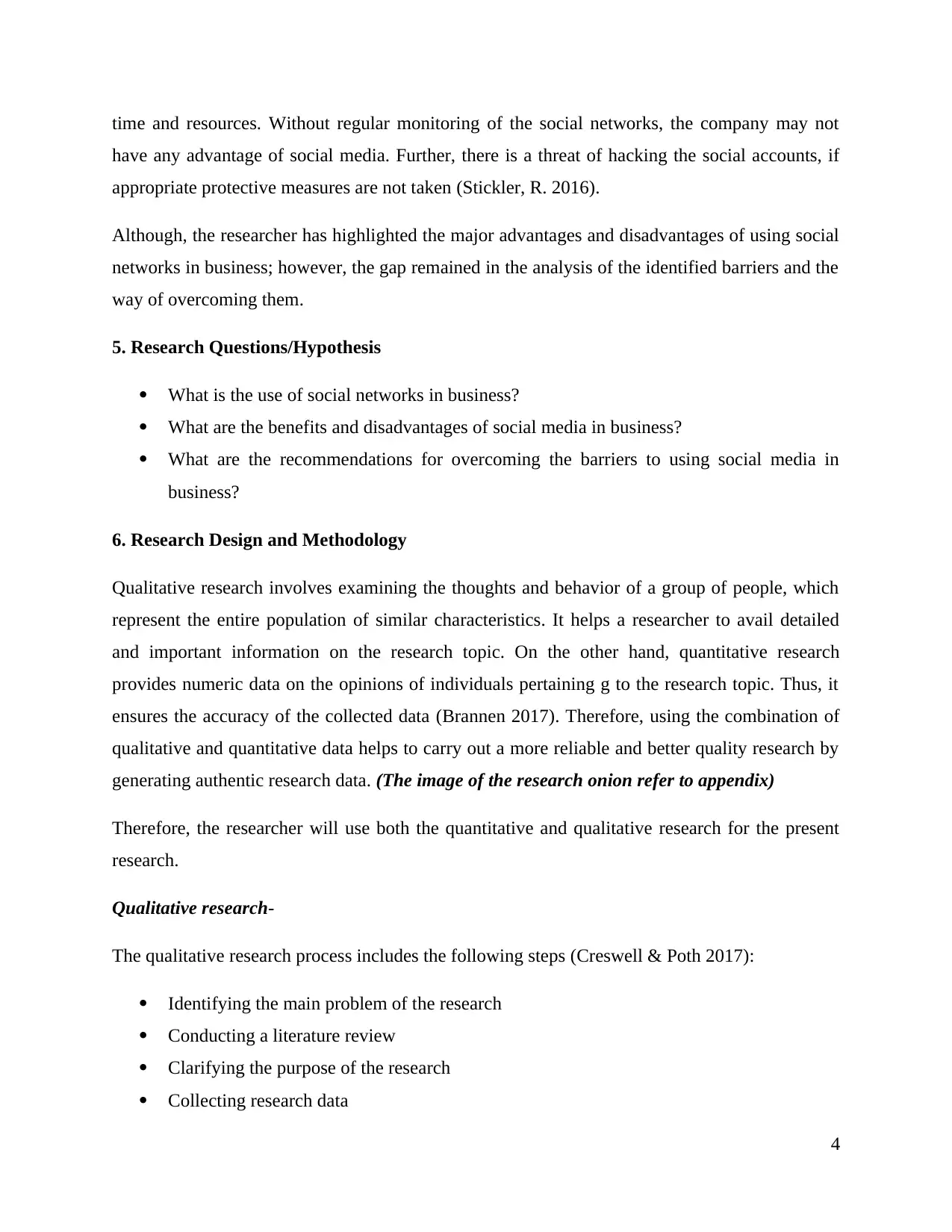
time and resources. Without regular monitoring of the social networks, the company may not
have any advantage of social media. Further, there is a threat of hacking the social accounts, if
appropriate protective measures are not taken (Stickler, R. 2016).
Although, the researcher has highlighted the major advantages and disadvantages of using social
networks in business; however, the gap remained in the analysis of the identified barriers and the
way of overcoming them.
5. Research Questions/Hypothesis
What is the use of social networks in business?
What are the benefits and disadvantages of social media in business?
What are the recommendations for overcoming the barriers to using social media in
business?
6. Research Design and Methodology
Qualitative research involves examining the thoughts and behavior of a group of people, which
represent the entire population of similar characteristics. It helps a researcher to avail detailed
and important information on the research topic. On the other hand, quantitative research
provides numeric data on the opinions of individuals pertaining g to the research topic. Thus, it
ensures the accuracy of the collected data (Brannen 2017). Therefore, using the combination of
qualitative and quantitative data helps to carry out a more reliable and better quality research by
generating authentic research data. (The image of the research onion refer to appendix)
Therefore, the researcher will use both the quantitative and qualitative research for the present
research.
Qualitative research-
The qualitative research process includes the following steps (Creswell & Poth 2017):
Identifying the main problem of the research
Conducting a literature review
Clarifying the purpose of the research
Collecting research data
4
have any advantage of social media. Further, there is a threat of hacking the social accounts, if
appropriate protective measures are not taken (Stickler, R. 2016).
Although, the researcher has highlighted the major advantages and disadvantages of using social
networks in business; however, the gap remained in the analysis of the identified barriers and the
way of overcoming them.
5. Research Questions/Hypothesis
What is the use of social networks in business?
What are the benefits and disadvantages of social media in business?
What are the recommendations for overcoming the barriers to using social media in
business?
6. Research Design and Methodology
Qualitative research involves examining the thoughts and behavior of a group of people, which
represent the entire population of similar characteristics. It helps a researcher to avail detailed
and important information on the research topic. On the other hand, quantitative research
provides numeric data on the opinions of individuals pertaining g to the research topic. Thus, it
ensures the accuracy of the collected data (Brannen 2017). Therefore, using the combination of
qualitative and quantitative data helps to carry out a more reliable and better quality research by
generating authentic research data. (The image of the research onion refer to appendix)
Therefore, the researcher will use both the quantitative and qualitative research for the present
research.
Qualitative research-
The qualitative research process includes the following steps (Creswell & Poth 2017):
Identifying the main problem of the research
Conducting a literature review
Clarifying the purpose of the research
Collecting research data
4
Paraphrase This Document
Need a fresh take? Get an instant paraphrase of this document with our AI Paraphraser
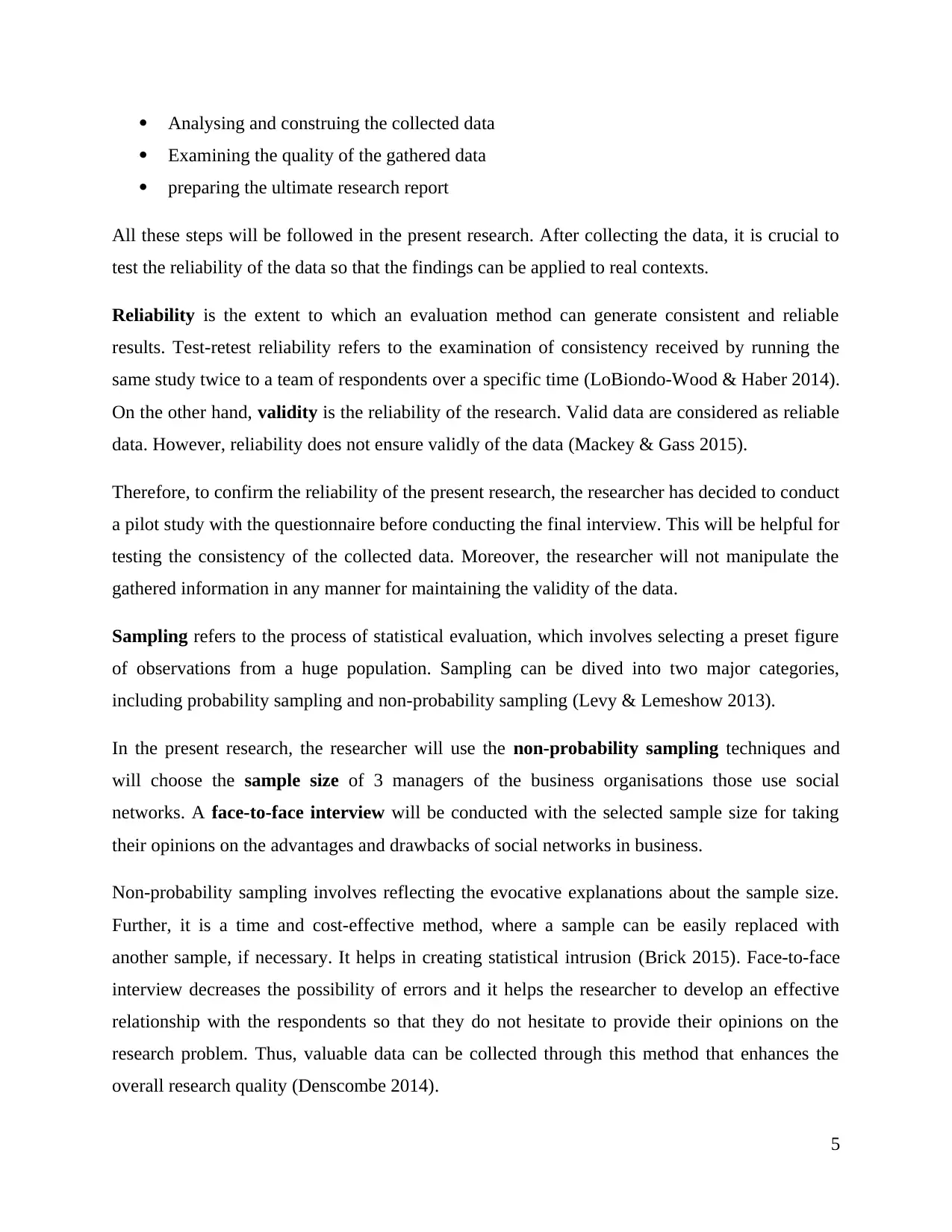
Analysing and construing the collected data
Examining the quality of the gathered data
preparing the ultimate research report
All these steps will be followed in the present research. After collecting the data, it is crucial to
test the reliability of the data so that the findings can be applied to real contexts.
Reliability is the extent to which an evaluation method can generate consistent and reliable
results. Test-retest reliability refers to the examination of consistency received by running the
same study twice to a team of respondents over a specific time (LoBiondo-Wood & Haber 2014).
On the other hand, validity is the reliability of the research. Valid data are considered as reliable
data. However, reliability does not ensure validly of the data (Mackey & Gass 2015).
Therefore, to confirm the reliability of the present research, the researcher has decided to conduct
a pilot study with the questionnaire before conducting the final interview. This will be helpful for
testing the consistency of the collected data. Moreover, the researcher will not manipulate the
gathered information in any manner for maintaining the validity of the data.
Sampling refers to the process of statistical evaluation, which involves selecting a preset figure
of observations from a huge population. Sampling can be dived into two major categories,
including probability sampling and non-probability sampling (Levy & Lemeshow 2013).
In the present research, the researcher will use the non-probability sampling techniques and
will choose the sample size of 3 managers of the business organisations those use social
networks. A face-to-face interview will be conducted with the selected sample size for taking
their opinions on the advantages and drawbacks of social networks in business.
Non-probability sampling involves reflecting the evocative explanations about the sample size.
Further, it is a time and cost-effective method, where a sample can be easily replaced with
another sample, if necessary. It helps in creating statistical intrusion (Brick 2015). Face-to-face
interview decreases the possibility of errors and it helps the researcher to develop an effective
relationship with the respondents so that they do not hesitate to provide their opinions on the
research problem. Thus, valuable data can be collected through this method that enhances the
overall research quality (Denscombe 2014).
5
Examining the quality of the gathered data
preparing the ultimate research report
All these steps will be followed in the present research. After collecting the data, it is crucial to
test the reliability of the data so that the findings can be applied to real contexts.
Reliability is the extent to which an evaluation method can generate consistent and reliable
results. Test-retest reliability refers to the examination of consistency received by running the
same study twice to a team of respondents over a specific time (LoBiondo-Wood & Haber 2014).
On the other hand, validity is the reliability of the research. Valid data are considered as reliable
data. However, reliability does not ensure validly of the data (Mackey & Gass 2015).
Therefore, to confirm the reliability of the present research, the researcher has decided to conduct
a pilot study with the questionnaire before conducting the final interview. This will be helpful for
testing the consistency of the collected data. Moreover, the researcher will not manipulate the
gathered information in any manner for maintaining the validity of the data.
Sampling refers to the process of statistical evaluation, which involves selecting a preset figure
of observations from a huge population. Sampling can be dived into two major categories,
including probability sampling and non-probability sampling (Levy & Lemeshow 2013).
In the present research, the researcher will use the non-probability sampling techniques and
will choose the sample size of 3 managers of the business organisations those use social
networks. A face-to-face interview will be conducted with the selected sample size for taking
their opinions on the advantages and drawbacks of social networks in business.
Non-probability sampling involves reflecting the evocative explanations about the sample size.
Further, it is a time and cost-effective method, where a sample can be easily replaced with
another sample, if necessary. It helps in creating statistical intrusion (Brick 2015). Face-to-face
interview decreases the possibility of errors and it helps the researcher to develop an effective
relationship with the respondents so that they do not hesitate to provide their opinions on the
research problem. Thus, valuable data can be collected through this method that enhances the
overall research quality (Denscombe 2014).
5
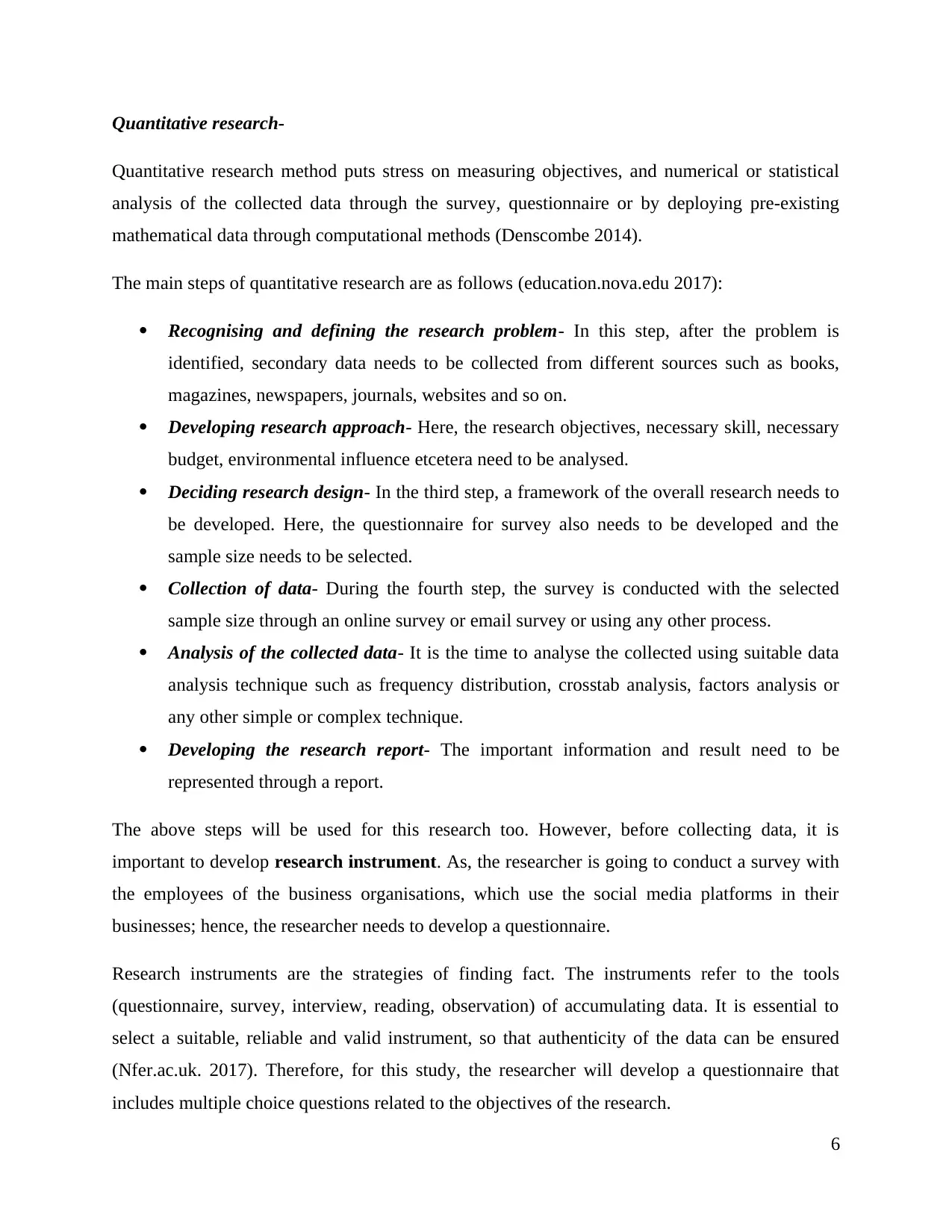
Quantitative research-
Quantitative research method puts stress on measuring objectives, and numerical or statistical
analysis of the collected data through the survey, questionnaire or by deploying pre-existing
mathematical data through computational methods (Denscombe 2014).
The main steps of quantitative research are as follows (education.nova.edu 2017):
Recognising and defining the research problem- In this step, after the problem is
identified, secondary data needs to be collected from different sources such as books,
magazines, newspapers, journals, websites and so on.
Developing research approach- Here, the research objectives, necessary skill, necessary
budget, environmental influence etcetera need to be analysed.
Deciding research design- In the third step, a framework of the overall research needs to
be developed. Here, the questionnaire for survey also needs to be developed and the
sample size needs to be selected.
Collection of data- During the fourth step, the survey is conducted with the selected
sample size through an online survey or email survey or using any other process.
Analysis of the collected data- It is the time to analyse the collected using suitable data
analysis technique such as frequency distribution, crosstab analysis, factors analysis or
any other simple or complex technique.
Developing the research report- The important information and result need to be
represented through a report.
The above steps will be used for this research too. However, before collecting data, it is
important to develop research instrument. As, the researcher is going to conduct a survey with
the employees of the business organisations, which use the social media platforms in their
businesses; hence, the researcher needs to develop a questionnaire.
Research instruments are the strategies of finding fact. The instruments refer to the tools
(questionnaire, survey, interview, reading, observation) of accumulating data. It is essential to
select a suitable, reliable and valid instrument, so that authenticity of the data can be ensured
(Nfer.ac.uk. 2017). Therefore, for this study, the researcher will develop a questionnaire that
includes multiple choice questions related to the objectives of the research.
6
Quantitative research method puts stress on measuring objectives, and numerical or statistical
analysis of the collected data through the survey, questionnaire or by deploying pre-existing
mathematical data through computational methods (Denscombe 2014).
The main steps of quantitative research are as follows (education.nova.edu 2017):
Recognising and defining the research problem- In this step, after the problem is
identified, secondary data needs to be collected from different sources such as books,
magazines, newspapers, journals, websites and so on.
Developing research approach- Here, the research objectives, necessary skill, necessary
budget, environmental influence etcetera need to be analysed.
Deciding research design- In the third step, a framework of the overall research needs to
be developed. Here, the questionnaire for survey also needs to be developed and the
sample size needs to be selected.
Collection of data- During the fourth step, the survey is conducted with the selected
sample size through an online survey or email survey or using any other process.
Analysis of the collected data- It is the time to analyse the collected using suitable data
analysis technique such as frequency distribution, crosstab analysis, factors analysis or
any other simple or complex technique.
Developing the research report- The important information and result need to be
represented through a report.
The above steps will be used for this research too. However, before collecting data, it is
important to develop research instrument. As, the researcher is going to conduct a survey with
the employees of the business organisations, which use the social media platforms in their
businesses; hence, the researcher needs to develop a questionnaire.
Research instruments are the strategies of finding fact. The instruments refer to the tools
(questionnaire, survey, interview, reading, observation) of accumulating data. It is essential to
select a suitable, reliable and valid instrument, so that authenticity of the data can be ensured
(Nfer.ac.uk. 2017). Therefore, for this study, the researcher will develop a questionnaire that
includes multiple choice questions related to the objectives of the research.
6
⊘ This is a preview!⊘
Do you want full access?
Subscribe today to unlock all pages.

Trusted by 1+ million students worldwide
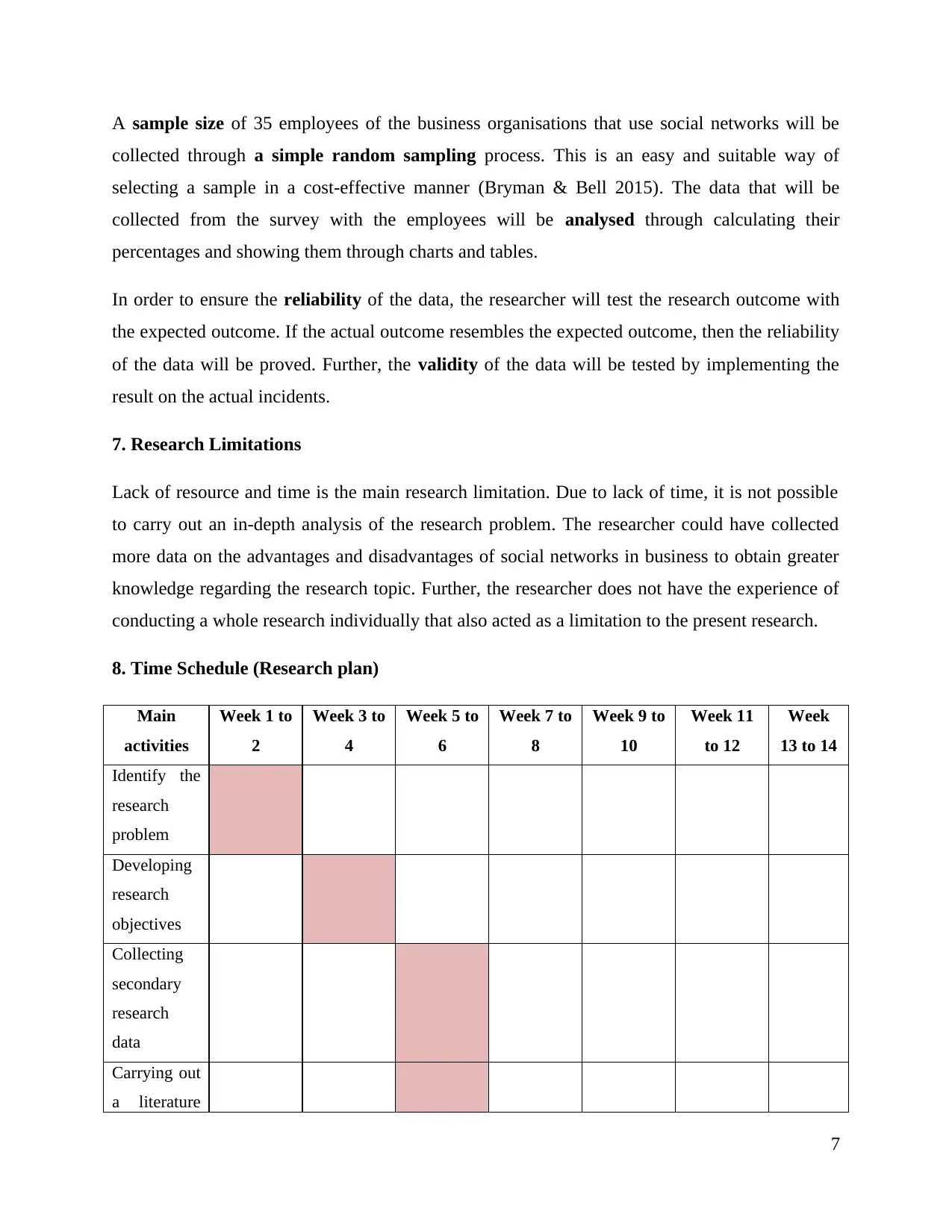
A sample size of 35 employees of the business organisations that use social networks will be
collected through a simple random sampling process. This is an easy and suitable way of
selecting a sample in a cost-effective manner (Bryman & Bell 2015). The data that will be
collected from the survey with the employees will be analysed through calculating their
percentages and showing them through charts and tables.
In order to ensure the reliability of the data, the researcher will test the research outcome with
the expected outcome. If the actual outcome resembles the expected outcome, then the reliability
of the data will be proved. Further, the validity of the data will be tested by implementing the
result on the actual incidents.
7. Research Limitations
Lack of resource and time is the main research limitation. Due to lack of time, it is not possible
to carry out an in-depth analysis of the research problem. The researcher could have collected
more data on the advantages and disadvantages of social networks in business to obtain greater
knowledge regarding the research topic. Further, the researcher does not have the experience of
conducting a whole research individually that also acted as a limitation to the present research.
8. Time Schedule (Research plan)
Main
activities
Week 1 to
2
Week 3 to
4
Week 5 to
6
Week 7 to
8
Week 9 to
10
Week 11
to 12
Week
13 to 14
Identify the
research
problem
Developing
research
objectives
Collecting
secondary
research
data
Carrying out
a literature
7
collected through a simple random sampling process. This is an easy and suitable way of
selecting a sample in a cost-effective manner (Bryman & Bell 2015). The data that will be
collected from the survey with the employees will be analysed through calculating their
percentages and showing them through charts and tables.
In order to ensure the reliability of the data, the researcher will test the research outcome with
the expected outcome. If the actual outcome resembles the expected outcome, then the reliability
of the data will be proved. Further, the validity of the data will be tested by implementing the
result on the actual incidents.
7. Research Limitations
Lack of resource and time is the main research limitation. Due to lack of time, it is not possible
to carry out an in-depth analysis of the research problem. The researcher could have collected
more data on the advantages and disadvantages of social networks in business to obtain greater
knowledge regarding the research topic. Further, the researcher does not have the experience of
conducting a whole research individually that also acted as a limitation to the present research.
8. Time Schedule (Research plan)
Main
activities
Week 1 to
2
Week 3 to
4
Week 5 to
6
Week 7 to
8
Week 9 to
10
Week 11
to 12
Week
13 to 14
Identify the
research
problem
Developing
research
objectives
Collecting
secondary
research
data
Carrying out
a literature
7
Paraphrase This Document
Need a fresh take? Get an instant paraphrase of this document with our AI Paraphraser
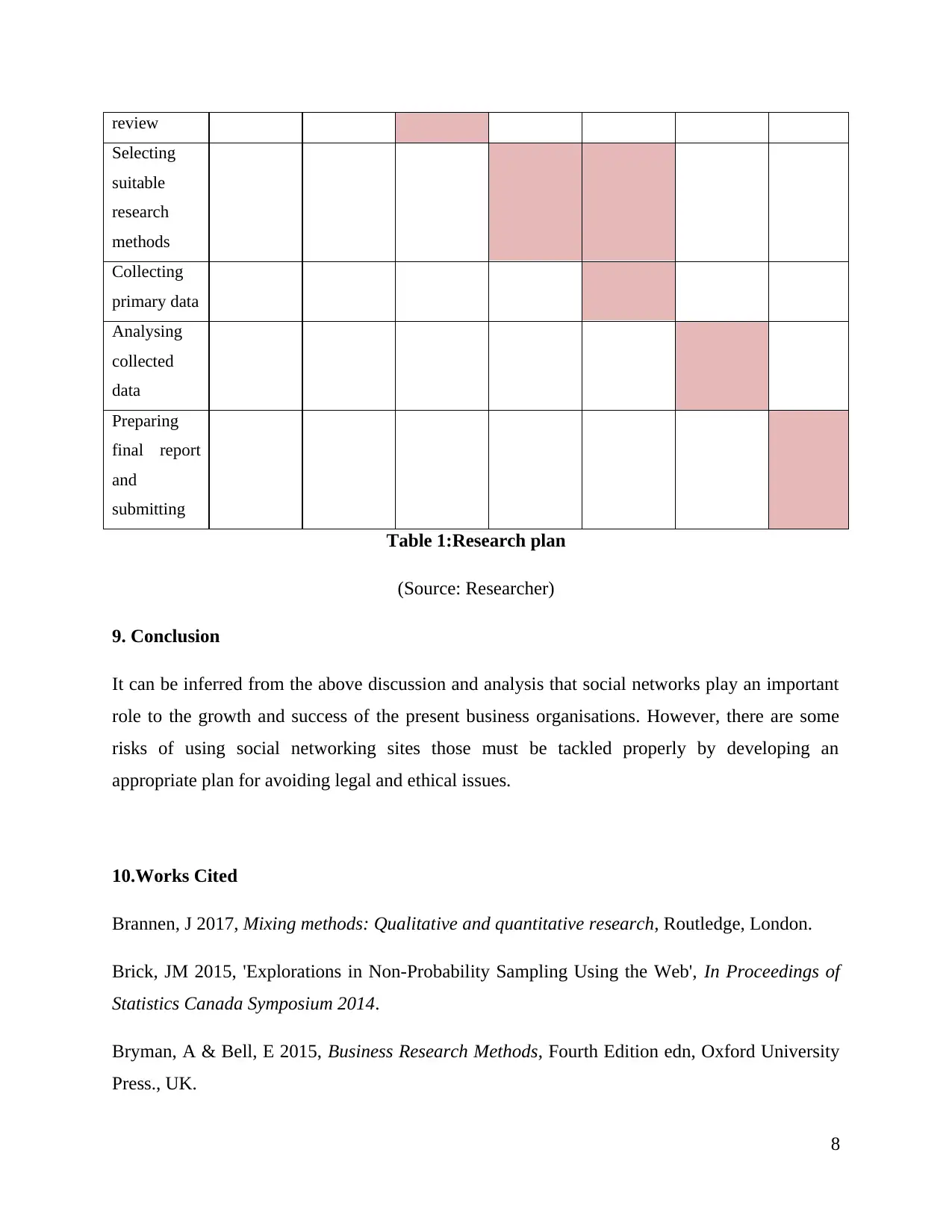
review
Selecting
suitable
research
methods
Collecting
primary data
Analysing
collected
data
Preparing
final report
and
submitting
Table 1:Research plan
(Source: Researcher)
9. Conclusion
It can be inferred from the above discussion and analysis that social networks play an important
role to the growth and success of the present business organisations. However, there are some
risks of using social networking sites those must be tackled properly by developing an
appropriate plan for avoiding legal and ethical issues.
10.Works Cited
Brannen, J 2017, Mixing methods: Qualitative and quantitative research, Routledge, London.
Brick, JM 2015, 'Explorations in Non-Probability Sampling Using the Web', In Proceedings of
Statistics Canada Symposium 2014.
Bryman, A & Bell, E 2015, Business Research Methods, Fourth Edition edn, Oxford University
Press., UK.
8
Selecting
suitable
research
methods
Collecting
primary data
Analysing
collected
data
Preparing
final report
and
submitting
Table 1:Research plan
(Source: Researcher)
9. Conclusion
It can be inferred from the above discussion and analysis that social networks play an important
role to the growth and success of the present business organisations. However, there are some
risks of using social networking sites those must be tackled properly by developing an
appropriate plan for avoiding legal and ethical issues.
10.Works Cited
Brannen, J 2017, Mixing methods: Qualitative and quantitative research, Routledge, London.
Brick, JM 2015, 'Explorations in Non-Probability Sampling Using the Web', In Proceedings of
Statistics Canada Symposium 2014.
Bryman, A & Bell, E 2015, Business Research Methods, Fourth Edition edn, Oxford University
Press., UK.
8

Creswell, JW & Poth, CN 2017, Qualitative inquiry and research design: Choosing among five
approaches, Sage publications, California.
Denscombe, M 2014, The good research guide: for small-scale social research projects,
McGraw-Hill Education, UK.
education.nova.edu 2017, viewed 18 September 2017,
<http://education.nova.edu/Resources/uploads/app/35/files/arc_doc/
quantitative_research_methods.pdf>.
Emily Copp 2016, Hootsuite Social Media Management, viewed 18 September 2017,
<https://blog.hootsuite.com/social-media-for-business/>.
Ku, D. 2016, Salesforlife.com., viewed 18 September 2017,
<http://www.salesforlife.com/blog/the-roi-of-social-selling-5-data-driven-outcomes-
infographic>.
Levy, PS & Lemeshow, S 2013, Sampling of populations: methods and applications, John Wiley
& Sons, New Jersey.
LoBiondo-Wood, G & Haber, J 2014, Reliability and validityG. LoBiondo-Wood & J. Haber.
Nursing research. Methods and critical appraisal for evidencebased practice.
Mackey, A & Gass, SM 2015, Second language research: Methodology and design, Routledge,
London.
Nfer.ac.uk. 2017, viewed 18 September 2017, <https://www.nfer.ac.uk/schools/developing-
young-researchers/how-to-develop-research-instruments/>.
Stickler, R. 2016, WebpageFX Blog, viewed 18 September 2017,
<https://www.webpagefx.com/blog/social-media/increase-sales-online-with-social-media/>.
11. Appendix
9
approaches, Sage publications, California.
Denscombe, M 2014, The good research guide: for small-scale social research projects,
McGraw-Hill Education, UK.
education.nova.edu 2017, viewed 18 September 2017,
<http://education.nova.edu/Resources/uploads/app/35/files/arc_doc/
quantitative_research_methods.pdf>.
Emily Copp 2016, Hootsuite Social Media Management, viewed 18 September 2017,
<https://blog.hootsuite.com/social-media-for-business/>.
Ku, D. 2016, Salesforlife.com., viewed 18 September 2017,
<http://www.salesforlife.com/blog/the-roi-of-social-selling-5-data-driven-outcomes-
infographic>.
Levy, PS & Lemeshow, S 2013, Sampling of populations: methods and applications, John Wiley
& Sons, New Jersey.
LoBiondo-Wood, G & Haber, J 2014, Reliability and validityG. LoBiondo-Wood & J. Haber.
Nursing research. Methods and critical appraisal for evidencebased practice.
Mackey, A & Gass, SM 2015, Second language research: Methodology and design, Routledge,
London.
Nfer.ac.uk. 2017, viewed 18 September 2017, <https://www.nfer.ac.uk/schools/developing-
young-researchers/how-to-develop-research-instruments/>.
Stickler, R. 2016, WebpageFX Blog, viewed 18 September 2017,
<https://www.webpagefx.com/blog/social-media/increase-sales-online-with-social-media/>.
11. Appendix
9
⊘ This is a preview!⊘
Do you want full access?
Subscribe today to unlock all pages.

Trusted by 1+ million students worldwide
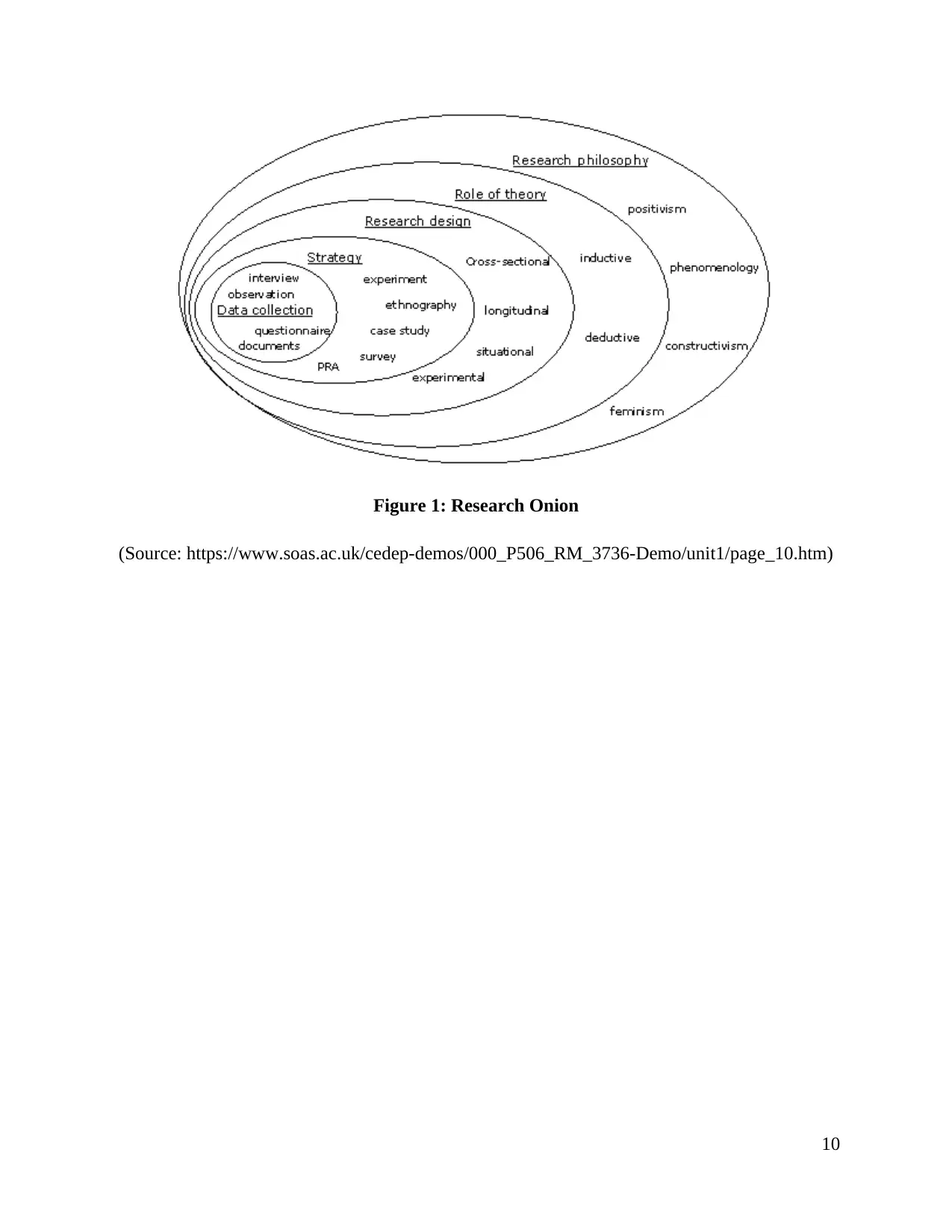
Figure 1: Research Onion
(Source: https://www.soas.ac.uk/cedep-demos/000_P506_RM_3736-Demo/unit1/page_10.htm)
10
(Source: https://www.soas.ac.uk/cedep-demos/000_P506_RM_3736-Demo/unit1/page_10.htm)
10
1 out of 10
Related Documents
Your All-in-One AI-Powered Toolkit for Academic Success.
+13062052269
info@desklib.com
Available 24*7 on WhatsApp / Email
![[object Object]](/_next/static/media/star-bottom.7253800d.svg)
Unlock your academic potential
Copyright © 2020–2025 A2Z Services. All Rights Reserved. Developed and managed by ZUCOL.





